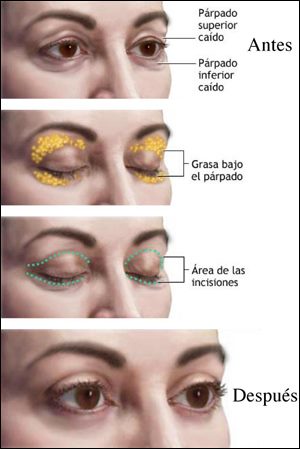EYELIDS, ORBIT AND AESTHETICS
OCULAR PLASTIC SURGERY
CAUSES
The main problem that we can find associated with this area is known as blepharitis. Blepharitis is the inflammation of the eyelids and occurs due to the abnormal secretion of fat by the glands in this area. Proper eyelid hygiene is essential to keep the area clean of fat.
This subspecialty of ophthalmology includes a great variety of surgical procedures that treat the affections of these structures as malpositions, inflammations or loss of elasticity of the eyelids, for example.
The surgical correction of these conditions or pathologies can be functional, aesthetic or both.
COMMON CONDITIONS THAT OCULOPLASTY CORRECTS
Below, we will briefly explain how oculoplastycorrects some of the most common conditions:
Blepharoplasty
The blepharoplasty or eyelid surgery is the surgical procedure in which the specialist can reshape or remove excess tissue from the upper and lower eyelids.
The surgery can be functional for a loss of vision due to the drooping of one or both eyelids (palpebral ptosis) or aesthetic to rejuvenate the face by removing excess skin (dermatochalasis).
- Palpebral ptosis: drooping of one or both eyelids.
- Dermatochalasis: excess skin on the eyelids that may be associated with a protrusion of fat.
Xanthelasma
Entropion and ectropion
The entropion occurs when the lower eyelid is reversed causing the eyelashes to rub against the eyeball which creates irritation in the cornea and conjunctiva. This produces in the patient a sensation of a weird body and a lot of tears.
El ectropión aparece cuando hay una eversión del borde palpebral por lo que está alejado de su posición normal. El paciente tendrá síntomas cuando el punto lagrimal se aleje. Es el proceso contrario al entropión. Se debe al envejecimiento.
Surgical treatment is chosen to treat these two conditions and thus improve the patient’s quality of life.
Facial paralysis
Lagophthalmos occurs when the patient has an incomplete closing of the eyelids.
This makes it possible for the patient to come to the clinic for problems with dry eyes that could worsen the quality of vision of the patient.
If it is mild, the treatment will consist of lubricating the eye. In more severe cases, surgery may be performed.

OCULAR PLASTIC SURGERY: PRE AND POSTOPERATIVE
Both preoperative and postoperative will vary depending on the surgery you undergo. We recommend that you visit your ophthalmologist for a complete annual check-up to assess any signs you may have.
Some recommendations after ocular plastic surgery are:
- It is advisable to sleep on your back.
- Wash the area with special care after surgery to avoid infection, irritation, etc.
- Carry out the cures indicated by the specialist on a daily basis.
- Do not wear makeup for one week after the operation.
- Follow the treatment prescribed by the specialist.
- During the first few days after the operation, the area will become inflamed, for which the application of cold compresses or ice is recommended.
- Itching, irritation, or excessive tearing may occur.
- Do not make sudden movements or great efforts.
- Avoid exposure to the sun until three months after the operation to promote healing.
- In order to eliminate the accumulation of liquids it is recommended to perform lymphatic drainage during the first week after surgery. In this way, the postoperative period will be reduced and recovery will be favored.
BENEFITS OF OCULOPLASTY
The benefits of oculoplasty or ocular plastic surgery are focused on solving pathological problems while at the same time covering aesthetic issues such as facial rejuvenation or modification of the appearance of the eyes.





